steering wheel SATURN ION 2007 Owner's Manual
[x] Cancel search | Manufacturer: SATURN, Model Year: 2007, Model line: ION, Model: SATURN ION 2007Pages: 440, PDF Size: 2.93 MB
Page 234 of 440
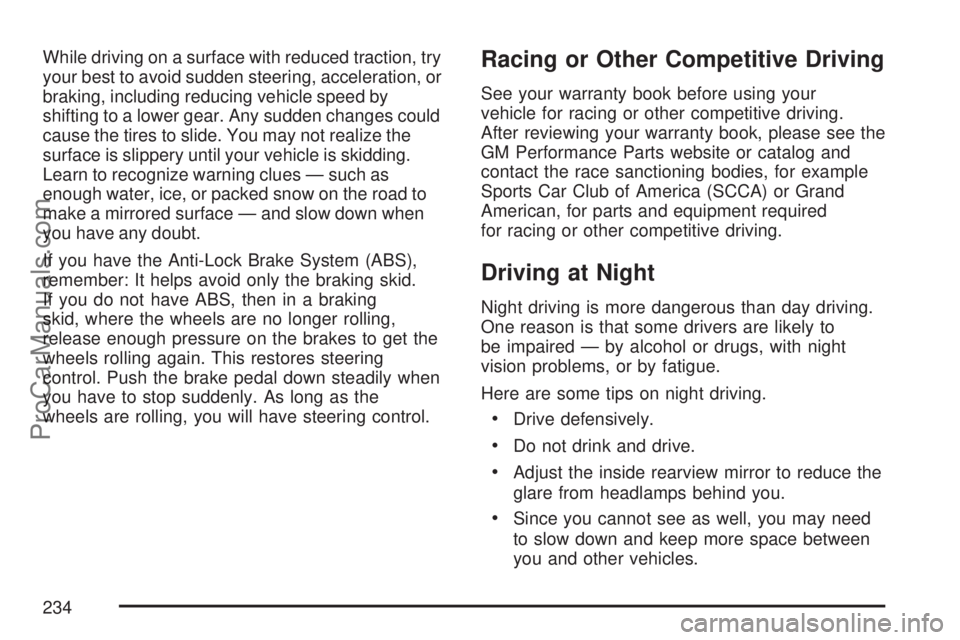
While driving on a surface with reduced traction, try
your best to avoid sudden steering, acceleration, or
braking, including reducing vehicle speed by
shifting to a lower gear. Any sudden changes could
cause the tires to slide. You may not realize the
surface is slippery until your vehicle is skidding.
Learn to recognize warning clues — such as
enough water, ice, or packed snow on the road to
make a mirrored surface — and slow down when
you have any doubt.
If you have the Anti-Lock Brake System (ABS),
remember: It helps avoid only the braking skid.
If you do not have ABS, then in a braking
skid, where the wheels are no longer rolling,
release enough pressure on the brakes to get the
wheels rolling again. This restores steering
control. Push the brake pedal down steadily when
you have to stop suddenly. As long as the
wheels are rolling, you will have steering control.Racing or Other Competitive Driving
See your warranty book before using your
vehicle for racing or other competitive driving.
After reviewing your warranty book, please see the
GM Performance Parts website or catalog and
contact the race sanctioning bodies, for example
Sports Car Club of America (SCCA) or Grand
American, for parts and equipment required
for racing or other competitive driving.
Driving at Night
Night driving is more dangerous than day driving.
One reason is that some drivers are likely to
be impaired — by alcohol or drugs, with night
vision problems, or by fatigue.
Here are some tips on night driving.
Drive defensively.
Do not drink and drive.
Adjust the inside rearview mirror to reduce the
glare from headlamps behind you.
Since you cannot see as well, you may need
to slow down and keep more space between
you and other vehicles.
234
ProCarManuals.com
Page 247 of 440
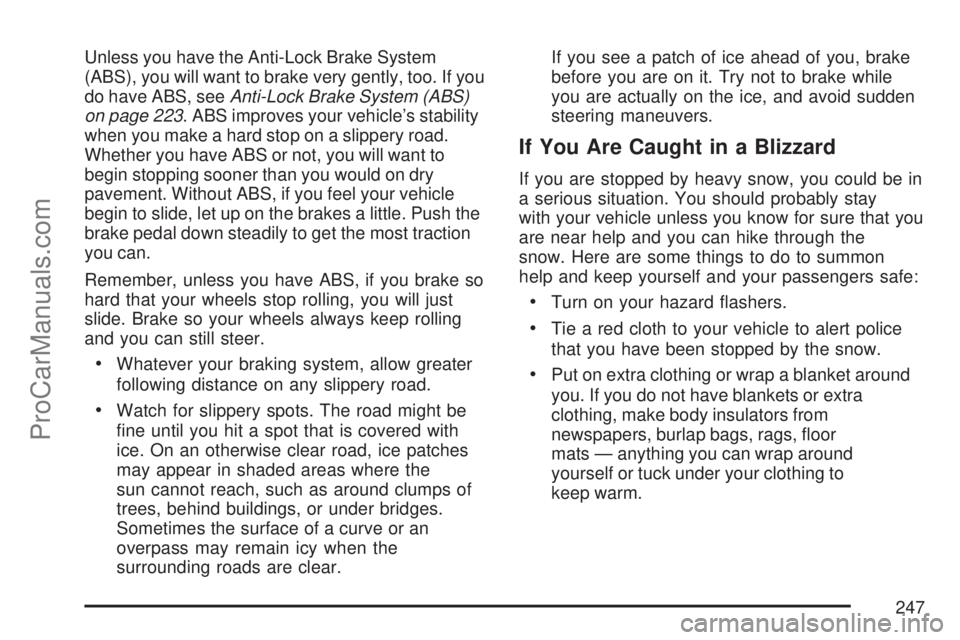
Unless you have the Anti-Lock Brake System
(ABS), you will want to brake very gently, too. If you
do have ABS, seeAnti-Lock Brake System (ABS)
on page 223. ABS improves your vehicle’s stability
when you make a hard stop on a slippery road.
Whether you have ABS or not, you will want to
begin stopping sooner than you would on dry
pavement. Without ABS, if you feel your vehicle
begin to slide, let up on the brakes a little. Push the
brake pedal down steadily to get the most traction
you can.
Remember, unless you have ABS, if you brake so
hard that your wheels stop rolling, you will just
slide. Brake so your wheels always keep rolling
and you can still steer.
Whatever your braking system, allow greater
following distance on any slippery road.
Watch for slippery spots. The road might be
�ne until you hit a spot that is covered with
ice. On an otherwise clear road, ice patches
may appear in shaded areas where the
sun cannot reach, such as around clumps of
trees, behind buildings, or under bridges.
Sometimes the surface of a curve or an
overpass may remain icy when the
surrounding roads are clear.If you see a patch of ice ahead of you, brake
before you are on it. Try not to brake while
you are actually on the ice, and avoid sudden
steering maneuvers.
If You Are Caught in a Blizzard
If you are stopped by heavy snow, you could be in
a serious situation. You should probably stay
with your vehicle unless you know for sure that you
are near help and you can hike through the
snow. Here are some things to do to summon
help and keep yourself and your passengers safe:
Turn on your hazard �ashers.
Tie a red cloth to your vehicle to alert police
that you have been stopped by the snow.
Put on extra clothing or wrap a blanket around
you. If you do not have blankets or extra
clothing, make body insulators from
newspapers, burlap bags, rags, �oor
mats — anything you can wrap around
yourself or tuck under your clothing to
keep warm.
247
ProCarManuals.com
Page 250 of 440
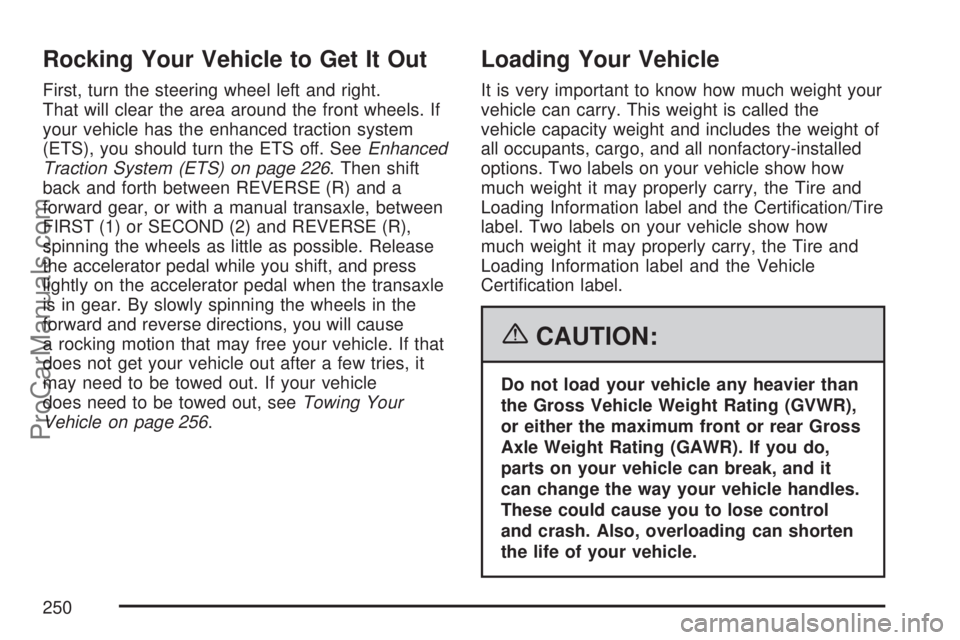
Rocking Your Vehicle to Get It Out
First, turn the steering wheel left and right.
That will clear the area around the front wheels. If
your vehicle has the enhanced traction system
(ETS), you should turn the ETS off. SeeEnhanced
Traction System (ETS) on page 226. Then shift
back and forth between REVERSE (R) and a
forward gear, or with a manual transaxle, between
FIRST (1) or SECOND (2) and REVERSE (R),
spinning the wheels as little as possible. Release
the accelerator pedal while you shift, and press
lightly on the accelerator pedal when the transaxle
is in gear. By slowly spinning the wheels in the
forward and reverse directions, you will cause
a rocking motion that may free your vehicle. If that
does not get your vehicle out after a few tries, it
may need to be towed out. If your vehicle
does need to be towed out, seeTowing Your
Vehicle on page 256.
Loading Your Vehicle
It is very important to know how much weight your
vehicle can carry. This weight is called the
vehicle capacity weight and includes the weight of
all occupants, cargo, and all nonfactory-installed
options. Two labels on your vehicle show how
much weight it may properly carry, the Tire and
Loading Information label and the Certi�cation/Tire
label. Two labels on your vehicle show how
much weight it may properly carry, the Tire and
Loading Information label and the Vehicle
Certi�cation label.
{CAUTION:
Do not load your vehicle any heavier than
the Gross Vehicle Weight Rating (GVWR),
or either the maximum front or rear Gross
Axle Weight Rating (GAWR). If you do,
parts on your vehicle can break, and it
can change the way your vehicle handles.
These could cause you to lose control
and crash. Also, overloading can shorten
the life of your vehicle.
250
ProCarManuals.com
Page 257 of 440
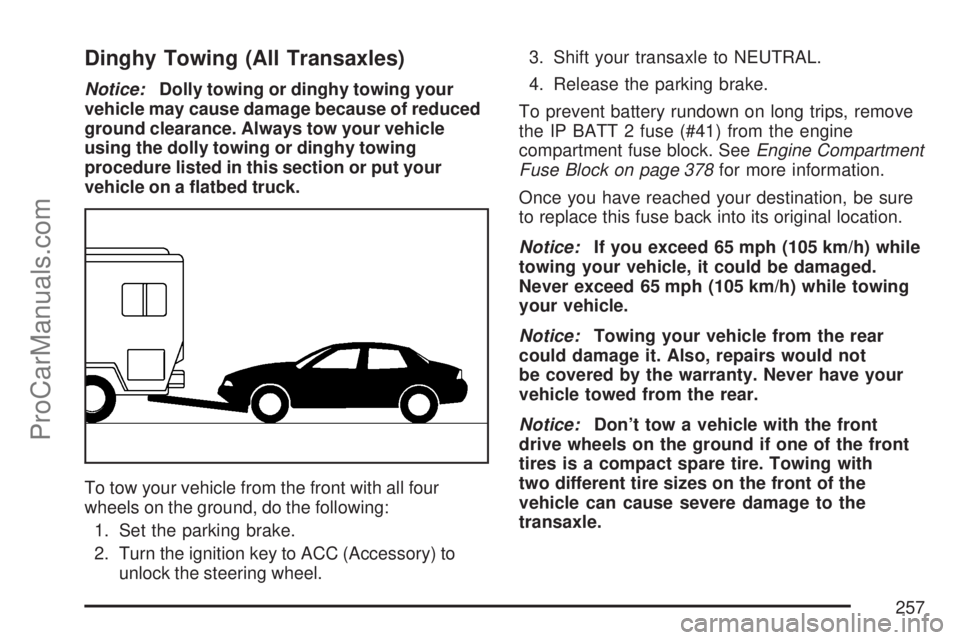
Dinghy Towing (All Transaxles)
Notice:Dolly towing or dinghy towing your
vehicle may cause damage because of reduced
ground clearance. Always tow your vehicle
using the dolly towing or dinghy towing
procedure listed in this section or put your
vehicle on a �atbed truck.
To tow your vehicle from the front with all four
wheels on the ground, do the following:
1. Set the parking brake.
2. Turn the ignition key to ACC (Accessory) to
unlock the steering wheel.3. Shift your transaxle to NEUTRAL.
4. Release the parking brake.
To prevent battery rundown on long trips, remove
the IP BATT 2 fuse (#41) from the engine
compartment fuse block. SeeEngine Compartment
Fuse Block on page 378for more information.
Once you have reached your destination, be sure
to replace this fuse back into its original location.
Notice:If you exceed 65 mph (105 km/h) while
towing your vehicle, it could be damaged.
Never exceed 65 mph (105 km/h) while towing
your vehicle.
Notice:Towing your vehicle from the rear
could damage it. Also, repairs would not
be covered by the warranty. Never have your
vehicle towed from the rear.
Notice:Don’t tow a vehicle with the front
drive wheels on the ground if one of the front
tires is a compact spare tire. Towing with
two different tire sizes on the front of the
vehicle can cause severe damage to the
transaxle.
257
ProCarManuals.com
Page 258 of 440

Dolly Towing (All Transaxles)
Notice:Dolly towing or dinghy towing your
vehicle may cause damage because of reduced
ground clearance. Always tow your vehicle
using the dolly towing or dinghy towing
procedure listed in this section or put your
vehicle on a �atbed truck.To tow your vehicle from the front with two wheels
on the ground, do the following:
1. Put the front wheels on a dolly.
2. If you have an automatic transaxle, shift the
transaxle to PARK (P). If you have a manual
transaxle, shift the vehicle to SECOND (2).
3. Set the parking brake and then remove
the key.
4. Clamp the steering wheel in a straight-ahead
position with a clamping device designed for
towing.
5. Release the parking brake.
258
ProCarManuals.com
Page 263 of 440

Driving with a Trailer
Towing a trailer requires a certain amount of
experience. Before setting out for the open road,
you’ll want to get to know your rig. Acquaint
yourself with the feel of handling and braking with
the added weight of the trailer. And always
keep in mind that the vehicle you are driving is
now a good deal longer and not nearly as
responsive as your vehicle is by itself.
Before you start, check the trailer hitch and
platform (and attachments), safety chains,
electrical connector, lamps, tires and mirror
adjustment. If the trailer has electric brakes, start
your vehicle and trailer moving and then apply
the trailer brake controller by hand to be sure the
brakes are working. This lets you check your
electrical connection at the same time.
During your trip, check occasionally to be sure
that the load is secure, and that the lamps and any
trailer brakes are still working.
Following Distance
Stay at least twice as far behind the vehicle ahead
as you would when driving your vehicle without
a trailer. This can help you avoid situations
that require heavy braking and sudden turns.
Passing
You will need more passing distance up ahead
when you’re towing a trailer. And, because you’re
a good deal longer when towing a trailer, you
will need to go much farther beyond the passed
vehicle before you can return to your lane.
Backing Up
Hold the bottom of the steering wheel with one
hand. Then, to move the trailer to the left,
just move that hand to the left. To move the trailer
to the right, move your hand to the right. Always
back up slowly and, if possible, have someone
guide you.
263
ProCarManuals.com
Page 349 of 440

If a Tire Goes Flat
It is unusual for a tire to blowout while you are
driving, especially if you maintain your vehicle’s
tires properly. If air goes out of a tire, it is
much more likely to leak out slowly. But if you
should ever have a blowout, here are a few tips
about what to expect and what to do:
If a front tire fails, the �at tire will create a drag
that pulls the vehicle toward that side. Take your
foot off the accelerator pedal and grip the
steering wheel �rmly. Steer to maintain lane
position, and then gently brake to a stop well out
of the traffic lane.
A rear blowout, particularly on a curve, acts much
like a skid and may require the same correction
you would use in a skid. In any rear blowout
remove your foot from the accelerator pedal.
Get the vehicle under control by steering the way
you want the vehicle to go. It may be very
bumpy and noisy, but you can still steer. Gently
brake to a stop, well off the road if possible.{CAUTION:
Lifting a vehicle and getting under it to do
maintenance or repairs is dangerous
without the appropriate safety equipment
and training. The jack provided with your
vehicle is designed only for changing a
�at tire. If it is used for anything else, you
or others could be badly injured or killed
if the vehicle slips off the jack. Use the
jack provided with your vehicle only for
changing a �at tire.
If a tire goes �at, the next part shows how to use the
jacking equipment to change a �at tire safely.
349
ProCarManuals.com
Page 395 of 440
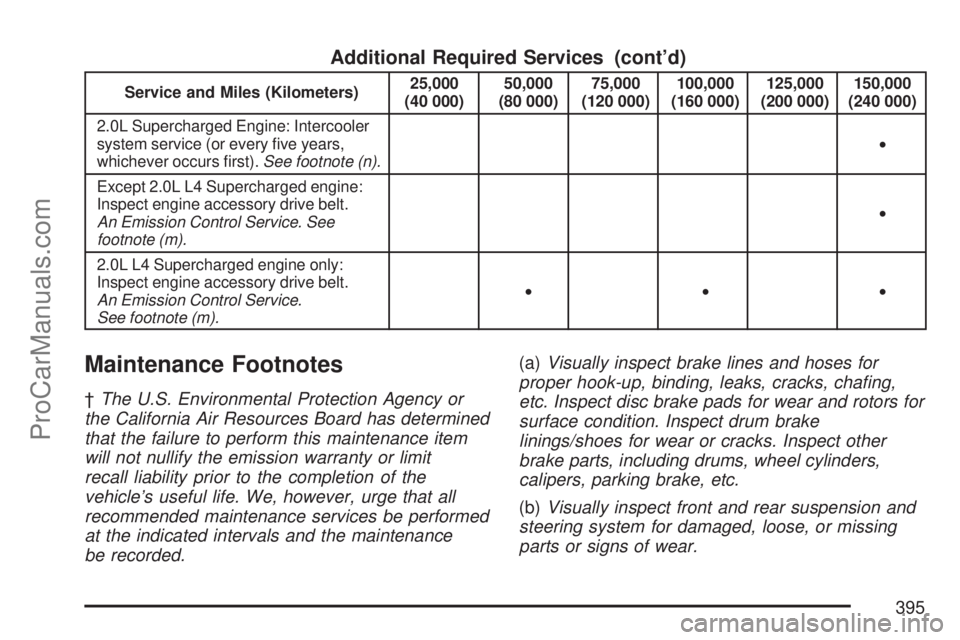
Additional Required Services (cont’d)
Service and Miles (Kilometers)25,000
(40 000)50,000
(80 000)75,000
(120 000)100,000
(160 000)125,000
(200 000)150,000
(240 000)
2.0L Supercharged Engine: Intercooler
system service (or every �ve years,
whichever occurs �rst).See footnote (n).•
Except 2.0L L4 Supercharged engine:
Inspect engine accessory drive belt.
An Emission Control Service. See
footnote (m).•
2.0L L4 Supercharged engine only:
Inspect engine accessory drive belt.
An Emission Control Service.
See footnote (m).•••
Maintenance Footnotes
†The U.S. Environmental Protection Agency or
the California Air Resources Board has determined
that the failure to perform this maintenance item
will not nullify the emission warranty or limit
recall liability prior to the completion of the
vehicle’s useful life. We, however, urge that all
recommended maintenance services be performed
at the indicated intervals and the maintenance
be recorded.(a)Visually inspect brake lines and hoses for
proper hook-up, binding, leaks, cracks, cha�ng,
etc. Inspect disc brake pads for wear and rotors for
surface condition. Inspect drum brake
linings/shoes for wear or cracks. Inspect other
brake parts, including drums, wheel cylinders,
calipers, parking brake, etc.
(b)Visually inspect front and rear suspension and
steering system for damaged, loose, or missing
parts or signs of wear.
395
ProCarManuals.com
Page 438 of 440
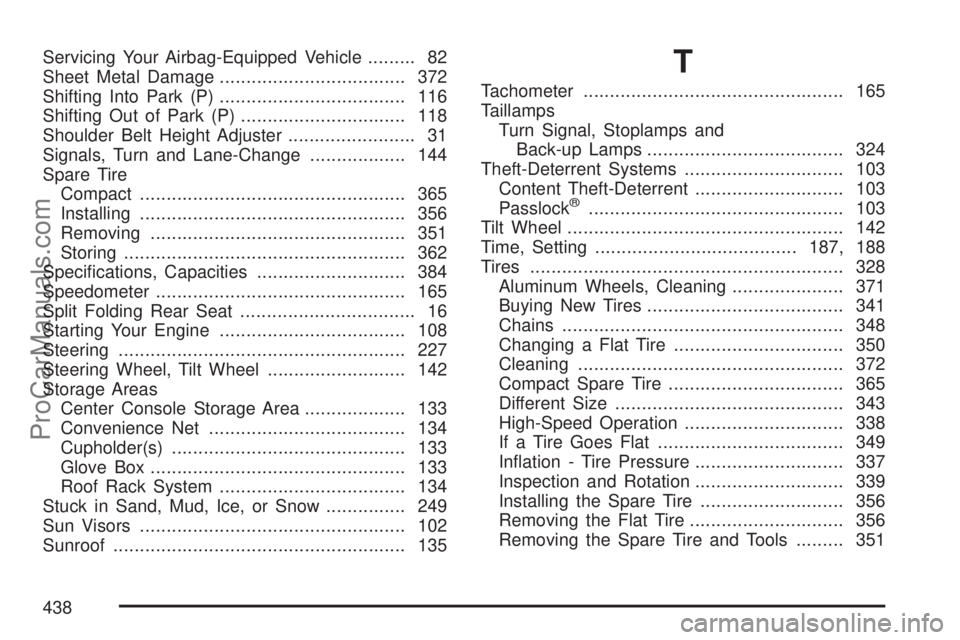
Servicing Your Airbag-Equipped Vehicle......... 82
Sheet Metal Damage................................... 372
Shifting Into Park (P)................................... 116
Shifting Out of Park (P)............................... 118
Shoulder Belt Height Adjuster........................ 31
Signals, Turn and Lane-Change.................. 144
Spare Tire
Compact.................................................. 365
Installing.................................................. 356
Removing................................................ 351
Storing..................................................... 362
Speci�cations, Capacities............................ 384
Speedometer............................................... 165
Split Folding Rear Seat................................. 16
Starting Your Engine................................... 108
Steering...................................................... 227
Steering Wheel, Tilt Wheel.......................... 142
Storage Areas
Center Console Storage Area................... 133
Convenience Net..................................... 134
Cupholder(s)............................................ 133
Glove Box................................................ 133
Roof Rack System................................... 134
Stuck in Sand, Mud, Ice, or Snow............... 249
Sun Visors.................................................. 102
Sunroof....................................................... 135T
Tachometer................................................. 165
Taillamps
Turn Signal, Stoplamps and
Back-up Lamps..................................... 324
Theft-Deterrent Systems.............................. 103
Content Theft-Deterrent............................ 103
Passlock
®................................................ 103
Tilt Wheel.................................................... 142
Time, Setting......................................187, 188
Tires........................................................... 328
Aluminum Wheels, Cleaning..................... 371
Buying New Tires..................................... 341
Chains..................................................... 348
Changing a Flat Tire................................ 350
Cleaning.................................................. 372
Compact Spare Tire................................. 365
Different Size........................................... 343
High-Speed Operation.............................. 338
If a Tire Goes Flat................................... 349
In�ation - Tire Pressure............................ 337
Inspection and Rotation............................ 339
Installing the Spare Tire........................... 356
Removing the Flat Tire............................. 356
Removing the Spare Tire and Tools......... 351
438
ProCarManuals.com